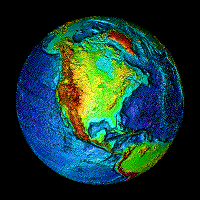VolcanoWatch Weekly [2 September 2009]
Posted by feww on September 5, 2009
Supervolcanoes may awaken
VOW: Mt Tambora

Photo: Mark Webster/Lonely Planet Images. Image may be subject to copyright.
Tambora Photo
Country: Indonesia
Region: Lesser Sunda Islands (Indonesia)
Volcano Type: Stratovolcano
Last Known Eruption: 1967 ± 20 years
Summit Elevation: 2,850 m (9,350 feet)
Latitude: 8.25°S
Longitude: 118.00°E
Source: GVP

Tambora volcano on Indonesia’s Sumbawa Island was the site of the world’s largest historical eruption in April 1815. This NASA Landsat mosaic shows the 6-km-wide caldera truncating the 2850-m-high summit of the massive volcano. Pyroclastic flows during the 1815 eruption reached the sea on all sides of the 60-km-wide volcanic peninsula, and the ejection of large amounts of tephra caused world-wide temperature declines in 1815 and 1816. NASA Landsat7 image (worldwind.arc.nasa.gov). Caption GVP.
Mount Tambora (or Tomboro) is an active stratovolcano on Sumbawa island, Indonesia. Sumbawa is flanked both to the north and south by oceanic crust, and Tambora was formed by the active subduction zones beneath it. This raised Mount Tambora as high as 4,300 m (14,000 ft), making it one of the tallest peaks in the Indonesian archipelago.
Tambora erupted in 1815 with a rating of seven on the Volcanic Explosivity Index, making it the largest eruption since the Lake Taupo eruption in about 180 AD. It was the largest volcanic eruption in recorded history. The explosion was heard on Sumatra island (more than 2,000 km away). Heavy volcanic ash falls were observed as far away as Borneo, Sulawesi, Java and Maluku islands. Most deaths from the eruption were from starvation and disease, as the eruptive fallout ruined agricultural productivity in the local region. The death toll was at least 71,000 people (perhaps the most deadly eruption in history), of whom 11,000–12,000 were killed directly by the eruption. The eruption created global climate anomalies; 1816 became known as the Year Without Summer because of the effect on North American and European weather. Agricultural crops failed and livestock died in much of the Northern Hemisphere, resulting in the worst famine of the 19th century. (Source: Wikipedia; edited by FEWW)
SI /USGS Weekly Volcanic Activity Report
(26 August-1 September 2009)
New activity/unrest:
- Kanlaon, Negros Island (central Philippines)
- Kolokol Group, Urup Island (Kurile Islands,Sakhalin Oblast region, Russia)
- Koryaksky, Eastern Kamchatka, Russia
Ongoing Activity:
- Batu Tara, Komba Island (Indonesia)
- Chaitén, Southern Chile
- Dukono, Halmahera
- Karymsky, Eastern Kamchatka
- Kilauea, Hawaii
- Kizimen, Eastern Kamchatka
- Pacaya, Guatemala
- Popocatépetl, México
- Rabaul, New Britain
- Sakura-jima, Kyushu (Japan)
- Santa María, Guatemala
- Shiveluch, Central Kamchatka (Russia)
- Suwanose-jima, Ryukyu Islands (Japan)
Related Links:
FEWW Links:

Climate Change: For what you’re about to receive… « Fire Earth said
[…] Supervolcanoes may awaken […]